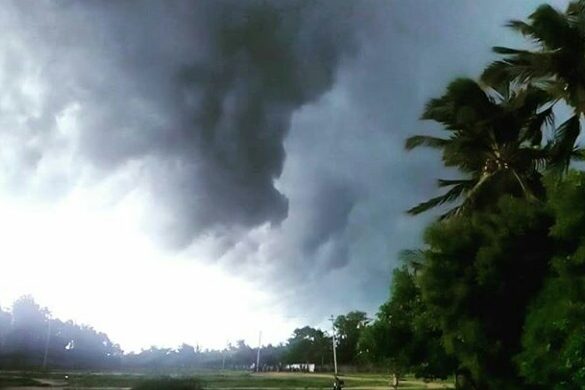Table of Contents
Artifacts of Cyclones in coastal India
Cyclones have been a recurring natural disaster in coastal India, causing significant damage to both human lives and infrastructure. These extreme weather events have left behind a trail of physical and emotional remnants that have long-lasting impacts on the coastal communities. As such, it is crucial to understand the artifacts of cyclones in coastal India and the measures taken to mitigate their effects. This article aims to explore the nature of cyclones in India, their impact on coastal communities, and the various infrastructural, community-based, and governmental measures in place to manage and mitigate the effects of these disasters.
1. Introduction: Cyclones in Coastal India
Cyclones are a frequent and destructive natural disaster that often hit the coastal regions of India. These tropical storms are formed from the combination of warm ocean water and atmospheric conditions, and can bring heavy rainfall, storm surges, and strong winds. Coastal regions in India such as Odisha, Andhra Pradesh, and Tamil Nadu are particularly vulnerable to these cyclones, which can cause significant damage to both infrastructure and communities in these regions.
Understanding Cyclone Formation and Frequency in Coastal India
Cyclones in India are usually formed in the Bay of Bengal and the Arabian Sea. With a coastline of over 7,500 kilometers, India is highly susceptible to the impact of cyclones. The frequency of cyclones has been increasing in recent years due to climate change and other environmental factors. Understanding the formation and behavior of these cyclones is critical in mitigating their impacts on coastal communities.
2. The Impact of Cyclones on Coastal Communities
The impact of cyclones on coastal communities can be both economic and social. Cyclones can cause extensive damage to infrastructure, businesses, and homes, affecting the livelihoods of people in these areas. Additionally, displacement due to cyclones can lead to humanitarian concerns such as lack of access to food, water, and health services.
Economic and Social Consequences of Cyclones
The economic impact of cyclones can be devastating for communities that rely on agriculture, fishing, and tourism. In addition to damage to crops and fisheries, cyclones can also destroy hotels and other tourist infrastructure. This can lead to long-term economic implications for the region.
Displacement and Humanitarian Concerns
The displacement caused by cyclones can be traumatic for individuals and families alike. Displaced families may struggle to access basic needs such as food, water, and shelter. Further, displacement can lead to loss of traditional livelihoods and cultural connections.
3. Artifacts of Cyclones in Coastal India: Physical and Emotional Remnants
Cyclones can leave behind physical artifacts of destruction and emotional trauma on the communities that they impact.
Physical Damage to Infrastructure and Environment
Cyclones can cause significant physical damage to the infrastructure and environment of coastal communities. This can include damage to roads, bridges, buildings, and power and water systems. Further, the storm surges associated with cyclones can lead to erosion and changes to the coastline.
Psychological Trauma and Resilience Strategies
The emotional toll of a cyclone can be long-lasting, particularly for individuals who have lost their homes, businesses, and loved ones. Resilience strategies such as community-based approaches that enable people to come together and recover after a cyclone can be critical in mitigating the emotional impact of these natural disasters.
4. The Role of Infrastructure in Mitigating and Dealing with Cyclone Damage
Building resilient infrastructure and early warning systems can be critical in mitigating the impact of cyclones on coastal communities.
Building Codes and Infrastructure Standards
Building codes and infrastructure standards can be critical in ensuring that buildings and other structures can withstand the impact of cyclones. This includes designing buildings that are resilient to wind and rain, as well as implementing safety protocols for high-risk areas such as coastal cities.
Early Warning Systems and Evacuation Plans
Early warning systems can help to alert communities of an impending cyclone, giving them time to prepare and evacuate if necessary. This can be critical in reducing the loss of life and preventing damage to infrastructure and properties. Evacuation plans should be established, communicated, and regularly tested, so that communities are equipped to respond effectively to cyclones.
5. Cyclone Preparedness and Response Measures
India has made significant efforts to prepare for and respond to cyclones, which have become more frequent and intense in recent years. Two key strategies have emerged for effectively managing these disasters: community-based disaster preparedness and coordination among government agencies and NGOs.
Community-Based Disaster Preparedness Strategies
Community-based disaster preparedness focuses on empowering local communities to take steps to mitigate the impact of a cyclone before it strikes. This includes identifying safe locations for evacuation and stockpiling emergency supplies like food, water, and first aid kits. It also means educating individuals on how to recognize the warning signs of a cyclone and how to protect themselves during the storm. By engaging the local population, these strategies help ensure that everyone is more prepared to deal with the cyclone's aftermath.
Coordination among Government Agencies and NGOs
Effective coordination among government agencies and NGOs is essential for an efficient and effective disaster response. This cooperation includes sharing information, resources, and expertise to provide disaster relief and recovery in the aftermath of a cyclone. NGOs and communities can also play an essential role in providing early warning and evacuation assistance, as well as supporting recovery efforts, such as the rebuilding of homes and infrastructure.
6. The Importance of Community Engagement in Cyclone Management
Communities living in coastal areas are most vulnerable to the devastating effects of cyclones. However, these communities also have the potential to play a critical role in managing these disasters. By engaging in disaster risk reduction and disaster response, communities can help reduce the impact of cyclones on their homes, families, and livelihoods.
Community Participation in Disaster Risk Reduction
Community participation in disaster risk reduction involves educating individuals on the risks they face and how to reduce these risks. This includes investing in flood-resistant infrastructure, developing early warning systems, and implementing emergency response plans. By working together, communities can reduce the impact of cyclones and other natural disasters.
Community-Based Disaster Response and Recovery Efforts
Community-based disaster response and recovery efforts involve mobilizing community members and resources to help those affected by a cyclone. This includes providing shelter, food, water, and medical care to those in need. Community organizations and NGOs can also help rebuild homes and infrastructure after a cyclone, ensuring that communities can recover and rebuild even after a significant disaster.
7. Conclusion: Building Resilience in Coastal India against Cyclones
Cyclones will continue to pose a significant threat to coastal communities in India. However, by implementing the strategies outlined above, communities can reduce the impact of these storms and recover more quickly from their effects. Building resilience against cyclones requires a collective effort from government agencies, NGOs, and communities. By working together, we can ensure that India's coastal communities are better prepared to face the challenges of these powerful storms.
Summarizing Key Points and Recommendations
- Community-based disaster preparedness and coordination among government agencies and NGOs are crucial for managing cyclones.
- Community engagement in disaster risk reduction and disaster response efforts plays an essential role in building resilience against cyclones.
- Community participation in risk reduction includes educating individuals on how to reduce risks and investing in flood-resistant infrastructure, early warning systems, and emergency response plans.
- Community-based disaster response efforts involve providing shelter, food, water, and medical care to those in need. NGOs and community organizations can help rebuild homes and infrastructure after a cyclone.
- A collective effort is required to build resilience against cyclones in India's coastal communities.In conclusion, managing the artifacts of cyclones in coastal India requires a comprehensive approach that involves various stakeholders, from the government and NGOs to community members and disaster management experts. By working together, sharing knowledge, and implementing appropriate measures, we can build resilience and reduce the impact of cyclones on coastal communities in India.
FAQ:
What causes cyclones in coastal India?
Cyclones in coastal India are caused by the meeting of two air masses, typically a low-pressure system and a high-pressure system, over the Bay of Bengal or the Arabian Sea. These air masses interact and form a rotating wind system that can lead to extreme weather events.
What are the long-term impacts of cyclones on coastal communities in India?
The long-term impacts of cyclones on coastal communities in India can be significant. They include physical damage to infrastructure, displacement of communities, loss of livelihoods, and psychological trauma. These impacts can lead to long-term poverty, economic instability, and a reduced quality of life for those affected.
What measures are in place to mitigate the impact of cyclones in coastal India?
There are various measures in place to mitigate the impact of cyclones in coastal India. These include early warning systems, evacuation plans, building codes and infrastructure standards, community-based disaster preparedness strategies, and coordination among government agencies and NGOs.
How can individuals help in managing the impact of cyclones in coastal India?
Individuals can play a crucial role in managing the impact of cyclones in coastal India by participating in community-based disaster preparedness strategies, staying informed about early warning systems and evacuation plans, and supporting organizations that work towards cyclone mitigation and relief efforts.




